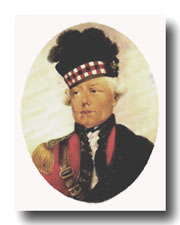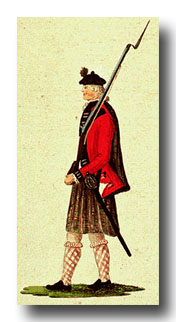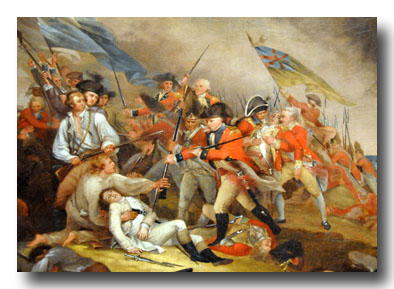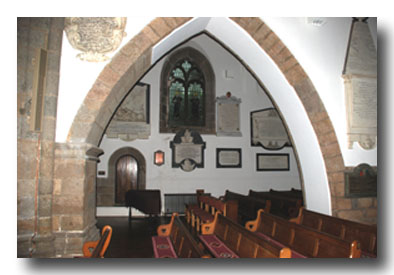Featured Biography
Lieutenant John Small (1726 - 1796)
 John Small was born at Strathardle in Athole, Scotland in 1726. After serving in the Scottish brigade in the Dutch service, he obtained a commission as ensign in the 42nd (Royal Highland) Regiment of Foot in 1747. This famed Scottish infantry regiment in the British Army became known as the Black Watch due to the dark color of the government issue tartan they were required to wear. On the eve of the departure of his regiment to America in 1756 he was appointed lieutenant.
John Small was born at Strathardle in Athole, Scotland in 1726. After serving in the Scottish brigade in the Dutch service, he obtained a commission as ensign in the 42nd (Royal Highland) Regiment of Foot in 1747. This famed Scottish infantry regiment in the British Army became known as the Black Watch due to the dark color of the government issue tartan they were required to wear. On the eve of the departure of his regiment to America in 1756 he was appointed lieutenant.
During the French and Indian War, Lt. John Small took part under Major General Abercrombie in the first battle of Ticonderoga, also known as the Battle of Carillon (1758). Although his regiment lost over half of its men in the assault Lt. Small survived. Thereafter in 1759, Small accompanied Sir Jeffrey Amherst in his expedition against Canada and it was during this period that Lt. Small became directly involved with the construction and improvement of the Crown Point Road.
Major General Jeffrey Amherst seized control of Fort St. Frederic on Lake Champlain, known by the British as Crown Point, in August 1759. Shortly thereafter, Amherst ordered the construction of a road across what is now Vermont to Fort No. 4 on the Connecticut River in order to facilitate the movement of troops and supplies, and to improve communications between British forces stationed along the frontier. A force of 200 Rangers under the command of Captain John Stark departed from the Fortress at Crown Point in August of 1759 and returned to Crown Point in September of that year after roughing out the road.
In October of 1759, as the approaching winter brought an end to the 1759 campaign, Amherst ordered Major John Hawks to command a force of 250 men "with proper tools" to resume completion of the military road. Lt. John Small was ordered to accompany Maj. Hawks in his expedition to improve the road and was dispatched by Amherst along with a party of thirty armed Regulars of the Royal Highland Regiment to guard and serve the expedition "for the good of the frontier". Lt. Small was also tasked to serve as paymaster for troops returning to New England.
Many details regarding the construction of the Crown Point Road are documented in letter reports from Lt. John Small to Gen. Jeffrey Amherst. Through this correspondence it has become evident that Lt. Small was a strong advocate for improvement of the road and that, beyond his assigned duties, he became involved in a personal crusade to improve the Crown Point Road.
Winter conditions set-in early in the fall of 1759. The severe weather, combined with the limited re-provisioning of Hawk's road building expedition, led to sickness, starvation, and desertion amongst Hawk's troops. Lt. Small's role during the fall of 1759 accordingly shifted from the task of guarding the road builders, to that of policing deserters. Indeed, it is documented in a letter to Amherst that, by the 5th of November, Lt. Small had apprehended 100 deserters from General Ruggle's Battalion working on the Crown Point Road. By Christmas Day 1759 discharged rangers and the last of the sick and lame provincials had arrived at Fort No. 4 to then set off for their respective homes.
Earlier, in the same month of December 1759 Lt. John Small dispatched a party of men to accompany Captain Caleb Willard, a well regarded surveyor, to search out a "way suitable for carriages" along the route of the Crown Point Road. Small thereafter reported in a dispatch to Amherst:
 "They return'd the 20th Dec, & reported to have found a Road & mark'd it most of the way from No. 4 beyond the heighths of land: and which they assuredly say does not Interfere with any hill Gully or Swamp; but Such as can be made practicable for carriages. I took a sketch & some observations of this newly mark'd Road; from their Journal & Survey of it. This I should have now transmitted to your Excellency but that in Crossing a River this Side, Houstack Mountains, & on my March hither, I had the Misfortune to gett all my papers wet; & with much difficulty & some danger I saved them from being entirely lost. I shall lose no time Sending them how Soon I can get them unfroze, Dryd & fitt for your Excellency's perusal"
"They return'd the 20th Dec, & reported to have found a Road & mark'd it most of the way from No. 4 beyond the heighths of land: and which they assuredly say does not Interfere with any hill Gully or Swamp; but Such as can be made practicable for carriages. I took a sketch & some observations of this newly mark'd Road; from their Journal & Survey of it. This I should have now transmitted to your Excellency but that in Crossing a River this Side, Houstack Mountains, & on my March hither, I had the Misfortune to gett all my papers wet; & with much difficulty & some danger I saved them from being entirely lost. I shall lose no time Sending them how Soon I can get them unfroze, Dryd & fitt for your Excellency's perusal"
On January 23, 1760, Lieutenant John Small summarized his last few days of work on the Crown Point Road to General Amherst. Small also described the progress under Major Hawks and complained about the eastern end of Captain Stark's route. Lt. Small's experience with military engineering was obviously at odds with that of Capt. Stark's as made obvious in this communiqué.
"I was sorry to see that Captn Stark (or his party) had for the last 14 or 15 Miles mark'd it [the Crown Point Road] across Several high Mountains steep rock precipices, & Deep Gullies: In Short through such Inaccessible ground; that most people who have past over it, agree with me in think it absolutely impossible ever to have a road this way that can be more practicable for any kind of Carriage. Major Hawks for this reason thought it needless to do any more to this last part of the road; than Clearing & removing a few log's out of the path. By his information in the woods, & by all the Intelligence I could pick up from the Inhabitants after we got to No. 4. I was convinc'd a better road (if not a good one) Could be found out if proper pains were taken to look for it. But Hawks Sent on was already too far advanc'd to have anything else done, at this time, than marking a road Suppose a good one was found; by which means the Garrison at Crownpoint would of course be desir'd of any advantage your Excellency had propos'd, they Should have; by this some communication being open'd to No. 4. On this last account, the Disappointment in the failure of the road was at this time more Considerable. I likewise knew that the Safety advantages and conveniencys that having a good road here would produce both to the Garrisons on Lake Champlain, & to the Country this Communication leads to: made your Excellency greatly & generously interested in its Succeeding. I was therefore resolv'd to do my utmost in endeavouring that this beneficial scheme Should be effected."
Lieutenant John Small's description of the condition of the Crown Point Road was not ignored by General Amherst and, in April of 1760, Amherst wrote to Governor Wentworth describing his disappointment with the completion of the road to date and advising the Governor that he intended to "cutt over anew" the road according to Lt. Small's recommendations. Shortly thereafter Amherst ordered a regiment of 800 men under Colonel John Goffe to begin construction of a more substantial road beginning at the Connecticut River and proceeding west toward the army at Crown Point. Amherst entrusted Lt. John Small of the Royal Highlanders to muster the New Hampshire regiment, pay them, and escort them to Fort Number Four on their mission "...to open the communication & Compleate the Road to Crown Point ..."
By November 1760 the Crown Point Road was completed to a level sufficient to facilitate the discharge of provincial soldiers from not only Crown Point and Ticonderoga, but also those stationed at Fort George and Fort Edward. By December of that year, John Small wrote to the commander at Fort No. 4, Lieutenant Colgahoun confirming poor winter conditions on the Crown Point Road and discouraging the further dispatch of travelers along the road.
In January of 1761, Governor Benning Wentworth sent out a party to survey some land between the Connecticut River and Otter Creek, but they soon returned do to harsh winter conditions. As spring approached that year, Small departed from Fort No. 4 on the 28th of March. It is unclear if Small's destination was Crown Point or Ticonderoga. Although traveling on snowshoes the deep snow was still soft and everyone's toes succumbed to some level of frostbite. At times the distance traveled did not exceed 6 or 7 miles a day. Yet despite these obstacles, and obsessed with improving the road, Small temporarily left his party and packs along the route near the end of Goffe's road and climbed one of the nearest summits to look for an alternate route to lake Champlain. Through the blowing snow he spotted an opening, or notch between two very high hills, in a more northwesterly direction than the existing road. The pass he observed appeared to provide a level and direct route toward Otter Creek. Small returned to the spot on the road from which he departed and marked the new route as they followed its course. By way of Ticonderoga Lt. John Small arrived at Crown Point in April of 1761.
On April 9, 1761 Lt. John Small wrote to General Amherst:
"And as I was very sensible that both a straighter and more Level Channel might be found for it than where it now passes the heighth of land or ridge of mountains between Connecticut River and the Lake where there has been little or nothing done yet towards clearing the road, I therefore resolv'd to persist in exerting myself as far it lay in my power, in endeavoring to trace a more feasible and more suitable road this way than any that has been hitherto found out. Indeed I was in hopes some of the provincial officers would have been spirited enough to have offer'd their assistance for this purpose (as they might reasonably be expected to understand the woods and this kind of service better than I) But not withstanding my mentioning and hinting to them that the honour and advantage to themselves and their country made them interested, in gratefully seconding your Excellency's generous measures, yet they seemed either not Sensible of what I said, or did not choose to put themselves in any sort of trouble, where they imagined no immediate or personal advantage would accrue to them. I consider'd their declining my proposals as no great disappointment, as their proceedings and reports (then as well as at other times) be very little to be depended upon."
A year later in 1762 Lt. John Small sailed with his regiment to the Caribbean island of Martinique and was made Captain. By 1765 Captain John Small had returned to America where he was appointed to a company of the 21st Regiment of Foot (the Scots Fusilier Regiment of Foot). Small served with the 21st in America until 1775 when he received an unofficial commission from General Gage, commander-in-chief of the British forces in North America, to raise the Young Royal Highlanders at his own expense. By June of 1775, in the early days of the American War of Independence, Small's Young Royal Highlanders were officially commissioned to become part of the 84th Regiment of Foot (Royal Highland Emigrants). The Regiment, consisting of 2000 men in 20 companies, was raised from Scottish soldiers who had served in the Seven Years' War and who had stayed in North America thereafter. As a result, the 84th Regiment had one of the oldest and most experienced officer corps of any Regiment in North America. The 84th Regiment was clothed, armed, and accoutered the same as the Black Watch, with now Major General John Small commanding the 2nd Battalion.

During the same month of June 1775, Small and his Scottish Highland Regiment fought in the Battle of Bunker Hill, the first major battle of the American Revolution. Major General Small was wounded in the arm by cannon fire during the course of the battle. Later, John Small was instrumental in assisting artist John Trumbull, who observed the actual battle through field glasses, in his iconic depiction of the Battle of Bunker Hill. In his famous painting titled "The Death of General Warren at the Battle of Bunker Hill" (Boston Museum of Fine Arts) Major General Small is at the center of the action, seizing the bayonet of one of his own Regiment before delivery of the final mark.
The divisions that the conflict created amongst men who served together during the French and Indian War, now friends who were subsequently caught on opposite sides of the conflict, are graphically depicted in both Trumbull's painting and as noted in John Small's reminiscence to the artist in 1786. John Small was apparently spared from death by his friend, now Rebel General Israel Putnam, who saved him from a bullet in the back as Small was slowly walking down hill, prepared for death, holding his wounded arm, behind his troops as they retreated from the second attack. Small describes to Trumbull:
"I do not like the situation in which you have placed my old friend Putnam; you have not done him justice. I wish you would alter that part of your picture, and introduce a circumstance which actually happened, and I could never forget. When the British troops advanced the second time to the attack of the redoubt, I, with other officers, was in the front of the line to encourage the men; we had advanced very near the works undisturbed, when an irregular fire like a feu-de-joie was poured in upon us; it was cruelly fatal. The troops fell back, and when I looked to the right and left, I saw not one officer standing; I glanced my eye to the enemy and saw several young men levelling their pieces at me; I knew their excellence as marksmen, and considered myself gone. At that moment my old friend Putnam rushed forward, and striking up the muzzles of their pieces with his sword cried out "for God's sake, my lads, don't fire at that man - I love him as I do my brother'. We were so near each other that I heard his words distinctly. He was obeyed; I bowed, thanked him, and walked away unmolested".
Small and his soldiers were successful on the third attack. The rebels fell into a panicked retreat, the slower men being put to the bayonet by the King's men, who were not mindful of the "criminals" who had murdered so many of their comrades. Small saved the famous rebel, Dr. Joseph Warren (another old friend) from being bayoneted as he lay on the ground. Small related to Artist Trumbull the demise of Doctor Warren:
"At the moment when the troops succeeded in carrying the redoubt, and the Americans were in full retreat, General Howe (who had been hurt by a spent ball which bruised his ankle) was leaning on my arm. He called suddenly to me: "Do you see that young man who has just fallen? Do you know him? I looked to the spot towards which he pointed - "Good God, Sir, I believe it is my friend Warren." "Leave me then instantly - run - keep off the troops, save him if possible". I flew to the spot, "My dear friend", I said to him, "I hope you are not badly hurt." - he looked up, seemed to recollect me, smiled and died! A musket ball had passed through the upper part of his head.
Thus is John Small's life, in part, chronicled during his campaigns with the British forces in North America, much consolidated here for the sake of brevity. After the American Revolution the Royal Highland Emigrants, 2nd Battalion, eventually settled in Hants County, Nova Scotia in Atlantic Canada. Small is reported to have built a manor house in Selma, Nova Scotia, known as "Selma Hall". By 1794, Small had returned to his homeland and later that year he became Lieutenant Governor of Guernsey and was promoted to the rank of Major General.
John Small led a seemingly charmed life, having spent almost 50 years in service to his King and Country, surviving historic battles with his Regiments and enduring years of harsh conditions, disease, and death along the frontier in America. John Small died in 1796. His remains are interred in the Town Church on the Channel Island of Guernsey, UK.
This biography of John Small has been compiled from archival research conducted by CPRA Vice President, Barry Griffith.